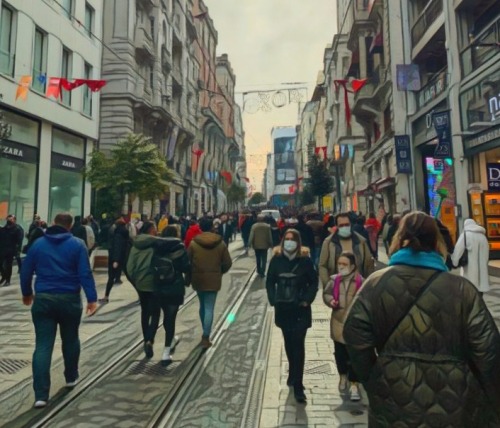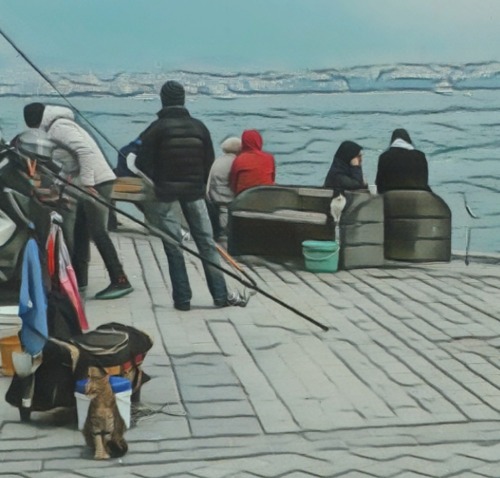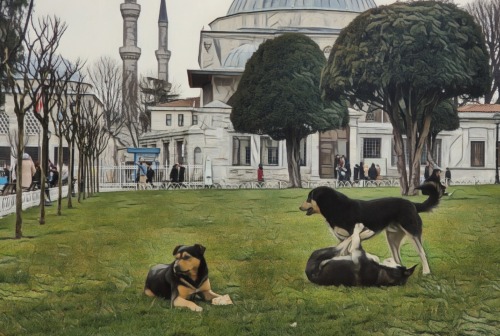
Istanbul is a city filled to the brim with life. The city is home to approximately 15 million people and millions more visit every year. While some parts of the city feel their presence more than others, life is everywhere.
On one end of the spectrum, there are the quiet neighborhood streets and hidden passageways of districts like Fener, Balat, and Cihangır. These neighborhoods are still lively, with residents going about their daily lives and the occasional tourist taking in the scenery, but these crowds are night and day when compared with the throngs of people crowding city mainstays like Galata, Sultanahmet, and Beşiktaş. These areas don’t just vibrate with life, they pound with it. Massive crowds of people stroll the famous Istiklal Caddesi every day—sometimes a trickle but mostly a deluge. Though weekday mornings feel relatively calm, punctuated by the buzzing of street cleaning machines and the footsteps of workers walking to their posts, by midday the street becomes a chaotic flood of visitors, residents, and the occasional and always unexpected vehicle. The crowds have no directionality and, if you’re trying to get somewhere quickly, you’ll find yourself dodging couples, strollers, and mopeds that are flowing both with and against you. The people of Istanbul, both permanent and temporary, flood the city with life.
But the life of Istanbul does not end with its people. Focus your eyes past the crowds and the cars and you’ll notice one of Istanbul’s most cherished demographics—the cats.
The cats of Istanbul are not simply pets or strays; they are residents that go about their daily business like any other Istanbulite. Like their human counterparts, the cats of Istanbul have neighborhood-specific cultures—some are friendly, some are skittish, and some are just plain rude. Little piles of food and miniature cat houses line the sidewalks to accommodate their wandering lifestyle, while shop owners and restaurateurs might leave their doors open a crack in case a cat feels inclined to patronize their business. Some cats avoid humans entirely, while others reciprocate these acts of care with cuddles, rodent-catching, or the simple honor of their presence. The lives of Istanbul’s cats are both independent and intertwined with the people of the city. Not entirely reliant on human care but also not entirely divorced from it either, the cats live their lives as any person would—sometimes accepting or lending help and sometimes refusing it altogether.

Photo: Street cats sit patiently waiting for fish
Less well-received are the stray dogs of Istanbul, which you’ll find either sleeping in tight little balls amongst patches of flowers and doorway nooks or leaping and rolling around with one another in moments of levity. Unlike the city’s cats, which have an air of indifference to human attention, the street dogs welcome it wholeheartedly. Show a street dog a bit of affection and you’ll have an escort all the way home. But for the most part, the dogs go about their daily lives just like everyone else—sleeping, socializing, and even commuting by metro or ferry, as is the case of world-famous street dog Boji.[1] You’re also likely to see their housed counterparts either through apartment windows or walking alongside their owners.

Photo: Street dogs playing together in Sultanahmet
While cats and dogs are amongst the most noticeable of Istanbul’s non-human occupants, you’ll also find a wide range of other residents. Look up and you’ll see the birds that roost in the city’s elaborate buildings and soar between them—the pigeons, the seagulls, and perhaps even the stray parakeet if you’re lucky. Wander along any waterway and you’ll find fishermen and seabirds working side-by-side to catch the fish that swim along the seashore, while cats linger alongside. Look a bit more closely at the water itself and you’ll observe copious amounts of jellyfish. You might even catch a glimpse of the more elusive dolphins, porpoises, seals, and whales that were once abundant in the Bosphorus. Every view, photo, or videoclip of Istanbul is teeming with animals just waiting to be spotted.
However, Istanbul is not entirely unique in this regard. While the ways in which humans and animals coexist in Istanbul are culturally and temporally specific, cities have always been home to a wide assortment of human and non-human animals interacting with one another in diverse ways. Sometimes these relationships are mutually beneficial, while other times they’re mutually or unilaterally antagonistic. Some animals are fed by humans, while others are expected to fend for themselves. Some animals are designated as “wild,” some “domestic,” and still others only temporarily “tamed.” Beyond mere domestication, sometimes specific animals are even given a sort of “personhood.” Whatever the specific dynamics of these relationships, and despite the tendency of modern scholarship and media to sanitize cities of their non-human occupants, the co-existence of humans and animals is clearly a foundational feature of urban life. While you might find conflicting opinions on Istanbul’s other animal residents, most would agree that an Istanbul without cats is not really Istanbul at all.

Photo: Fishermen and seagulls work together to catch fish at Galata Bridge
Within the world’s first cities, on which my own research focuses, diverse human and animal communities would have coexisted at an unprecedented scale. While you can easily observe the types of human-animal relationships and interactions that structure modern Istanbul by walking its streets and speaking to its human residents, it is much harder to reconstruct the ways in which these relationships impacted the development of the world’s first cities and, subsequently, ancient urban life overall. My own research pursues a combination of archaeological, historical, and iconographic evidence to better understand the relationships between humans and animals that structured the Bronze Age city of Hattuša (ca. 2000–1200 BC), which was both one of Anatolia’s first cities and the first imperial capital of Anatolia. While Hattuša was not nearly the size of modern Istanbul, many of the types of human-animal interactions that take place within Istanbul would have also taken place in and around this ancient city. In addition to those animals and relationships described above, Hattuša would have been packed with all manner of livestock, including sheep, goats, cows, pigs, and horses. Archaeological and historical evidence even suggest that the city occasionally hosted wild predators, such as lions, leopards, and bears, much like the menageries of Ottoman Istanbul. During my time as a PhD Fellow at ANAMED, I endeavor to reveal the details of this multispecies landscape by analyzing the animal bones recovered during excavation of this ancient city and piecing together what life was like for these early urbanites. By reconceptualizing modern and ancient cities as multispecies landscapes, modern and ancient cities alike become more realistic and inherently complex environments, where social life is shaped by these multifaceted interactions. One need only look around on an average stroll through Istanbul to recognize this diversity.
——————————————————————————————————————————-
Reference
Imamoğlu, Ekrem. [@ekrem_imamoglu]. (2022, January 11). Boji’nin artık rahatlıkla dolaşabileceği, özgürce koşabileceği bir yuvası var. İstanbul’un dünyaca meşhur köpeği Boji’yi sahiplenen iş insanı Ömer Koç’a teşekkürler. Boji’nin, ona zarar vermek isteyen insanlardan uzak, korunaklı, dilediği gibi koşturabileceği bir yuvası olacak. [Tweet]. Twitter. https://twitter.com/ekrem_imamoglu/status/1480952406997409799?s=20&t=lxvrsqmuEa5lC2FhjnNdeg
[1] Istanbul’s famous “commuter dog” has been adopted by Ömer Koç, chairman of Koç Holding (Imamoğlu, 2022).

